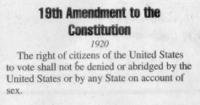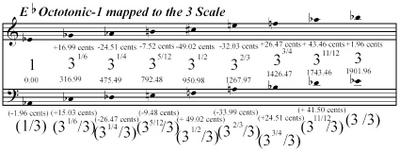 The E Flat Aeolian 2% wide Scale.
The E Flat Aeolian 2% wide Scale.
Wednesday, August 31, 2005
Music for 17 Musicians
 Via Robert Gable's aworks my attention is drawn to Allan Kozinn's account of a recent performance of Terry Riley's In C by the Composer's Collaborative at the Cornelia Street Cafe in NYC. Quoting from Kozinn:
Via Robert Gable's aworks my attention is drawn to Allan Kozinn's account of a recent performance of Terry Riley's In C by the Composer's Collaborative at the Cornelia Street Cafe in NYC. Quoting from Kozinn:"The score, for an ensemble of unspecified size and instrumentation, is built of 53 short figures that all the musicians are to play, though not in unison, with repetitions as the players see fit. There is also usually a repeating C, in octaves, played as a pulse that runs through the work, although this time the ensemble -- billed as the Mighty CCI House Band -- elected to drop it. That decision, though it made the piece sound slightly naked at first, allowed for an extra measure of fluidity in this already free-flowing score."
I've heard several live performances and recordings of In C over the years and those repeating C's (the highest ones on the piano) are seared into my brain. It is hard to imagine the opening major third of that piece without that persistent pulse/drone backing it up. I would love to hear a performance without it. There should be at least a couple of generations of performers fluent in the language of minimalism by now that performing this work without an audible "click track" should become common practice.
Another substantial work in the "minimalist" canon is Music for 18 Musicians by Steve Reich. (I look forward to a definitive Canteloupe release of this work that matches the high quality of the Alarm Will Sound performance of Tehillim, the So Percussion version of Drumming or the Bang on a Can All-Stars take on Riley's In C.) Music for 18 Musicians has a shaker part that plays a steady pulse of eighth notes throughout this 55-minute work and I've
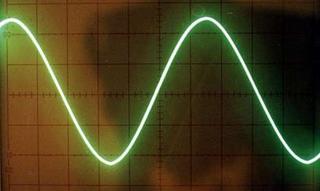 always been curious to hear this piece without that element cutting across the sonic canvas in such even intervals.
always been curious to hear this piece without that element cutting across the sonic canvas in such even intervals.The steady "pulse" of minimalism is so strong that physically articulating it seems redundant. Not that anyone has ever accused minimalism of redundancy. Taking out the steady-state element would expose a wider range of shades as the ever present pulse would be allowed to become implied at times and enhance the fluidity and harmonic content of these works.
Tuesday, August 30, 2005
Monday, August 29, 2005
Sunday, August 28, 2005
Saturday, August 27, 2005
Friday, August 26, 2005
Scale of the Day: E Flat Aeolian augmented 4
Fine Works in Recent HurdAudio Rotation
I've been drinking in a lot of great music lately. Here are some works that really caught my attention this past week:
 Charles Ives: Sonata No. 3 for Violin and Piano. Easily my favorite of the four sonatas for this instrumentation. This is the one that quotes the "I Need Thee Every Hour" hymn extensively (exactly the same one I used in my String Quartet No. 3). This work is appropriately called a sonata for violin and piano as each paints a sonic soundscape without one instrument taking a focal point at the expense of the other. These Ives compositions continue to sound better each time I revisit them.
Charles Ives: Sonata No. 3 for Violin and Piano. Easily my favorite of the four sonatas for this instrumentation. This is the one that quotes the "I Need Thee Every Hour" hymn extensively (exactly the same one I used in my String Quartet No. 3). This work is appropriately called a sonata for violin and piano as each paints a sonic soundscape without one instrument taking a focal point at the expense of the other. These Ives compositions continue to sound better each time I revisit them.
 Arnold Schoenberg: Kammersymphonie Op. 9 in E Major. It seems I can never listen to this one only once in a given sitting. Those stacked fourths forming a harmony that strains mightily against the tonal fabric are sonically addictive to my sensibilities. This is a rare chamber work of substantial intellectual gravity that demands a repeat listening almost immediately after hearing it.
Arnold Schoenberg: Kammersymphonie Op. 9 in E Major. It seems I can never listen to this one only once in a given sitting. Those stacked fourths forming a harmony that strains mightily against the tonal fabric are sonically addictive to my sensibilities. This is a rare chamber work of substantial intellectual gravity that demands a repeat listening almost immediately after hearing it.
 Steve Reich: Drumming. The So Percussion recording of this work is crisp and exquisite. The transition between Part II and Part III was unusually trance inducing in this most recent listening as the low frequency content seemed to fall away leaving the cyclical patterns exposed in the higher registers.
Steve Reich: Drumming. The So Percussion recording of this work is crisp and exquisite. The transition between Part II and Part III was unusually trance inducing in this most recent listening as the low frequency content seemed to fall away leaving the cyclical patterns exposed in the higher registers.
Thomas Albert: A Maze (With Grace) and Devil's Rain performed by the Relache Ensemble. Like Ives, Albert draws upon a hymn tune to animate A Maze as fragments from Amazing Grace slowly drift in and out of focus before settling in on a beautiful instrumental arrangement of the complete hymn. Amazing Grace has such a great melody that I've always preferred in instrumental manifestations. I find the words unnerving and somewhat heavy-handed against the sonic "grace" of the exposed melodic line. Devil's Run is a pulsating, aesthetically satisfying counter-balance to A Maze. I'm less familiar with Thomas Albert than with Ives, Schoenberg or Reich. This is some nice ensemble writing and arranging and I'd love to hear more.
Like Ives, Albert draws upon a hymn tune to animate A Maze as fragments from Amazing Grace slowly drift in and out of focus before settling in on a beautiful instrumental arrangement of the complete hymn. Amazing Grace has such a great melody that I've always preferred in instrumental manifestations. I find the words unnerving and somewhat heavy-handed against the sonic "grace" of the exposed melodic line. Devil's Run is a pulsating, aesthetically satisfying counter-balance to A Maze. I'm less familiar with Thomas Albert than with Ives, Schoenberg or Reich. This is some nice ensemble writing and arranging and I'd love to hear more.
 Charles Ives: Sonata No. 3 for Violin and Piano. Easily my favorite of the four sonatas for this instrumentation. This is the one that quotes the "I Need Thee Every Hour" hymn extensively (exactly the same one I used in my String Quartet No. 3). This work is appropriately called a sonata for violin and piano as each paints a sonic soundscape without one instrument taking a focal point at the expense of the other. These Ives compositions continue to sound better each time I revisit them.
Charles Ives: Sonata No. 3 for Violin and Piano. Easily my favorite of the four sonatas for this instrumentation. This is the one that quotes the "I Need Thee Every Hour" hymn extensively (exactly the same one I used in my String Quartet No. 3). This work is appropriately called a sonata for violin and piano as each paints a sonic soundscape without one instrument taking a focal point at the expense of the other. These Ives compositions continue to sound better each time I revisit them. Arnold Schoenberg: Kammersymphonie Op. 9 in E Major. It seems I can never listen to this one only once in a given sitting. Those stacked fourths forming a harmony that strains mightily against the tonal fabric are sonically addictive to my sensibilities. This is a rare chamber work of substantial intellectual gravity that demands a repeat listening almost immediately after hearing it.
Arnold Schoenberg: Kammersymphonie Op. 9 in E Major. It seems I can never listen to this one only once in a given sitting. Those stacked fourths forming a harmony that strains mightily against the tonal fabric are sonically addictive to my sensibilities. This is a rare chamber work of substantial intellectual gravity that demands a repeat listening almost immediately after hearing it. Steve Reich: Drumming. The So Percussion recording of this work is crisp and exquisite. The transition between Part II and Part III was unusually trance inducing in this most recent listening as the low frequency content seemed to fall away leaving the cyclical patterns exposed in the higher registers.
Steve Reich: Drumming. The So Percussion recording of this work is crisp and exquisite. The transition between Part II and Part III was unusually trance inducing in this most recent listening as the low frequency content seemed to fall away leaving the cyclical patterns exposed in the higher registers.Thomas Albert: A Maze (With Grace) and Devil's Rain performed by the Relache Ensemble.
 Like Ives, Albert draws upon a hymn tune to animate A Maze as fragments from Amazing Grace slowly drift in and out of focus before settling in on a beautiful instrumental arrangement of the complete hymn. Amazing Grace has such a great melody that I've always preferred in instrumental manifestations. I find the words unnerving and somewhat heavy-handed against the sonic "grace" of the exposed melodic line. Devil's Run is a pulsating, aesthetically satisfying counter-balance to A Maze. I'm less familiar with Thomas Albert than with Ives, Schoenberg or Reich. This is some nice ensemble writing and arranging and I'd love to hear more.
Like Ives, Albert draws upon a hymn tune to animate A Maze as fragments from Amazing Grace slowly drift in and out of focus before settling in on a beautiful instrumental arrangement of the complete hymn. Amazing Grace has such a great melody that I've always preferred in instrumental manifestations. I find the words unnerving and somewhat heavy-handed against the sonic "grace" of the exposed melodic line. Devil's Run is a pulsating, aesthetically satisfying counter-balance to A Maze. I'm less familiar with Thomas Albert than with Ives, Schoenberg or Reich. This is some nice ensemble writing and arranging and I'd love to hear more.
Thursday, August 25, 2005
Wednesday, August 24, 2005
De Profundis
 Tonight I am listening to De Profundis composed and, in this recording, performed by Frederic Rzewski. Add this work to my short list of text compositions that pin my ears back and deliver a transcendent impact. This work is a solo for a single performer at the piano with the addition of whistles, hums, breathing and a great deal of spoken word drawn from Oscar Wilde.
Tonight I am listening to De Profundis composed and, in this recording, performed by Frederic Rzewski. Add this work to my short list of text compositions that pin my ears back and deliver a transcendent impact. This work is a solo for a single performer at the piano with the addition of whistles, hums, breathing and a great deal of spoken word drawn from Oscar Wilde.The words are incredible. I really need to read some Wilde sometime soon.
 Written while imprisoned for "homosexual offenses" these words capture a profound sense of bitter injustice and ruthless indictment of a cruel social order. These words seem to capture the essence of so many of my own thoughts that they seem to speak "for" and "to" me with more eloquence than I would have imagined for such ideas. The sense of alienation, of feeling completely apart from the "other-ness" of society at large is palpable and familiar.
Written while imprisoned for "homosexual offenses" these words capture a profound sense of bitter injustice and ruthless indictment of a cruel social order. These words seem to capture the essence of so many of my own thoughts that they seem to speak "for" and "to" me with more eloquence than I would have imagined for such ideas. The sense of alienation, of feeling completely apart from the "other-ness" of society at large is palpable and familiar.Rzewski's superb piano intensifies the passion and intimacy of the text. The sonic space is inhabited in equal parts by notes and words with neither serving as accompaniment or prop. The fact that each emanates from a single performer adds to the intensity and sense of solitude. At times the extended techniques, both in voice and playing the "body" of the piano, paints a portrait of losing battles for sanity only to snap right back with a long string of deeply thoughtful, uncompromising text over spare chordal harmony. This composition does the subject matter enormous justice. I regard it as one of Rzewski's most inspired works.
With Wilde's words: "Religion does not help me" in my ears and mind I consider the recent fatwah issued by the Ayatollah of the 700 Club against Venezuelan President Hugo Chavez. Apparently it is deeply unchristian for a democratically elected leader to use oil wealth to address the plight of his nation's poor. Invoking the boogie-men of "Islamic extremism" and "communism" seems to be a mere cover for despot-envy for this televangelist joker. The "other-ness" depicted by Oscar Wilde seems more vivid when Cindy Sheehan is derided as "extreme" while this vile breed of fundamentalism has the ear of those in power. Camp Casey is the current manifestation of a proud tradition of dissent. CBN is a conduit for Christian extremism that needs to be mocked and ridiculed mercilessly.
Tuesday, August 23, 2005
Monday, August 22, 2005
Saturday, August 20, 2005
Friday, August 19, 2005
Thursday, August 18, 2005
George Russell
 I ran across this article about George Russell today. I've long been a big fan of his music and his harmonic conceptions. His Lydian Chromatic Theory of Tonal Organization has shaped many of my own ideas and was particularly valuable when I decided to return to the scale as a conceptual framework after a long spell of atonal/tone-row based approaches to harmony.
I ran across this article about George Russell today. I've long been a big fan of his music and his harmonic conceptions. His Lydian Chromatic Theory of Tonal Organization has shaped many of my own ideas and was particularly valuable when I decided to return to the scale as a conceptual framework after a long spell of atonal/tone-row based approaches to harmony.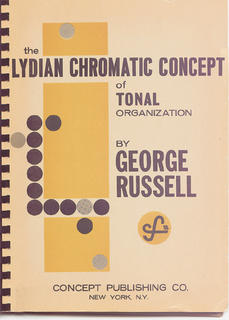
I once met George Russell briefly in Philadelphia after a concert. I remember that concert well, four works by four composers that have had a strong pull on me: George Russell, James Tenney, Stephen Montague and Alvin Curran. I shook Russell's hand and took some satisfaction in crossing paths with this mind who had set fire to my imagination with The Stratus Seekers and inspired my practice of polytonally imposing one scale over another in jazz piano improvisation. Leaning on that augmented fourth in a major tonality context was a quick way to avoid the problematic, and "square," sound of that perfect fourth that jars against the major third even as a passing tone. Building outward toward Augmented Lydian scales or referencing a tonic a tritone away from the implied root of a given context also proved to be a great way to sound "out" yet consistent relative to the prevailing harmonic terrain. This appealed to my modal sensibilities while still striking a degree of chromatic sophistication.
I look forward to hearing his new 2-CD of live music from his 80th birthday
 celebration a couple years back. Now retired from teaching at the New England Conservatory (where he established their jazz department) where he helped advance the study of jazz composition and theory I suspect he's just beginning to receive the accolades his lifetime of creative work deserves.
celebration a couple years back. Now retired from teaching at the New England Conservatory (where he established their jazz department) where he helped advance the study of jazz composition and theory I suspect he's just beginning to receive the accolades his lifetime of creative work deserves.The unusual combination of Russell's theories with the just intonation of Harry Partch is exactly the harmonic territory I wish to explore. My own "Scale of the Day" activities is an outgrowth of my studies of Russell's theories. Harmony is expansive and Russell is a great innovator in building outward along this parameter.
Wednesday, August 17, 2005
Crawford Crosses
 The Cindy Sheehan story continues to unfold with amazing gravity. Late last night some local redneck decided to run over the crosses set up as a memorial to the fallen soldiers in Iraq with his pickup. This act of violent stupidity led to his arrest and also added even more international attention and focus on this amazing vigil. This is how the "supporters" of this war show respect for those who perished in this conflict? With "support" like this who need dissenters?
The Cindy Sheehan story continues to unfold with amazing gravity. Late last night some local redneck decided to run over the crosses set up as a memorial to the fallen soldiers in Iraq with his pickup. This act of violent stupidity led to his arrest and also added even more international attention and focus on this amazing vigil. This is how the "supporters" of this war show respect for those who perished in this conflict? With "support" like this who need dissenters?No one was hurt in this incident so it's easy to see the positives. Violence is the resort of fools and it only sharpens the contrast between the substance of Sheehan's question about the "noble cause" versus the empty rhetoric of "staying the course." This yahoo with the truck pretty well reinforced every Lone Star stereotype held by the blue states. And unwittingly played right into the message of this protest.

This scene in Crawford is full of stark contrast. The feeble counter-demonstration a few days ago was short and populated by people who have no personal stake in this war. Even their chant: "We Don't Care" pretty well summed up the gaping hole in this entire conflict. The people who shout their "support" the loudest can barely muster more than a magnetic yellow ribbon on the back of their cars. The so-called sympathy expressed by the commander and chief is cheap. Which is more than I can say for a gallon of gasoline.
Tuesday, August 16, 2005
Monday, August 15, 2005
Scale of the Day: F Locrian diminished 4
Anthemic Re:Action
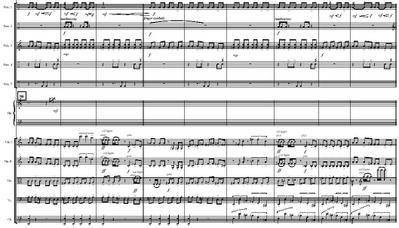 I've tossed another mp3 file of an early project over at SoundClick. Anthemic Re:Action is an orchestral sketch set to an introductory action sequence that was essentially a trailer for a larger project I was working on professionally. Everything was notated right down to parts and the plan was to record everything in Eastern Europe where orchestras are cheap(er). Ultimately the project was canceled but it was a fine exercise in imitating a "cinematic" orchestral sound for HurdAudio. Listening to it now I can hear traces of my "subversive" personality poking through in the orchestration, rhythm and form.
I've tossed another mp3 file of an early project over at SoundClick. Anthemic Re:Action is an orchestral sketch set to an introductory action sequence that was essentially a trailer for a larger project I was working on professionally. Everything was notated right down to parts and the plan was to record everything in Eastern Europe where orchestras are cheap(er). Ultimately the project was canceled but it was a fine exercise in imitating a "cinematic" orchestral sound for HurdAudio. Listening to it now I can hear traces of my "subversive" personality poking through in the orchestration, rhythm and form.
Sunday, August 14, 2005
Saturday, August 13, 2005
Friday, August 12, 2005
Is Our Children Evolving?
 The simmering fires of Tennessee vs. John Scopes of 1925 were rekindled in a press conference last week when Mr. "No Child Left Behind" suggested that the "theory" of Intelligent Design should be included in the public school science classroom as a "competing theory" to evolution. This is a thinly disguised effort to further erode the separation of church and state. But I don't think the level of decay between the separation of state and church has been explored completely enough...
The simmering fires of Tennessee vs. John Scopes of 1925 were rekindled in a press conference last week when Mr. "No Child Left Behind" suggested that the "theory" of Intelligent Design should be included in the public school science classroom as a "competing theory" to evolution. This is a thinly disguised effort to further erode the separation of church and state. But I don't think the level of decay between the separation of state and church has been explored completely enough... Therefore I propose that Evolution be included in church sermons as a competing "orthodoxy" to Creationism. Every Bible should be required to display a sticker that reads: "Creationism is only a myth, not a theory." Just think
Therefore I propose that Evolution be included in church sermons as a competing "orthodoxy" to Creationism. Every Bible should be required to display a sticker that reads: "Creationism is only a myth, not a theory." Just think 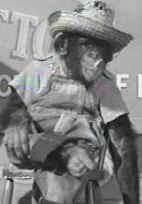 of all the children who may be graduating from their Sunday School curriculum without having The Origin of the Species to "balance" out the Book of Genesis. These impressionable minds taking in the gospels of Matthew, Mark, Luke and John without the secular counterbalance of Darwin, Dawkins, Gould and Dennett. Years of seminary courses focused on Noah's Ark filled with two of every animal without making any mention of the rich diversity of species found on the Galapagos Islands. Such teaching could churn out generations untroubled by "evidence" (or lack thereof) or "peer review." Such unbalance conjures up classrooms filled with students sitting crookedly at their desks as all their left buttocks have been amputated as part of the "No Child Left Behind" requirement. We simply cannot let these unaccountable, tax-exempt churches corrupt our precious youth any longer with such one-sided, faith-based indoctrination any longer.
of all the children who may be graduating from their Sunday School curriculum without having The Origin of the Species to "balance" out the Book of Genesis. These impressionable minds taking in the gospels of Matthew, Mark, Luke and John without the secular counterbalance of Darwin, Dawkins, Gould and Dennett. Years of seminary courses focused on Noah's Ark filled with two of every animal without making any mention of the rich diversity of species found on the Galapagos Islands. Such teaching could churn out generations untroubled by "evidence" (or lack thereof) or "peer review." Such unbalance conjures up classrooms filled with students sitting crookedly at their desks as all their left buttocks have been amputated as part of the "No Child Left Behind" requirement. We simply cannot let these unaccountable, tax-exempt churches corrupt our precious youth any longer with such one-sided, faith-based indoctrination any longer.Update: Perhaps we should take this particular fight to Kansas first. Clearly they're in the most danger of abandoning the values that come from a good, old fashioned secular education.
Thursday, August 11, 2005
Wednesday, August 10, 2005
Requiem
 Today is the 60th anniversary of the devastation of Nagasaki, the second use of an atomic weapon in wartime. Like Hiroshima just three days earlier, this attack took an enormous civilian toll that cannot be justified and must never be repeated.
Today is the 60th anniversary of the devastation of Nagasaki, the second use of an atomic weapon in wartime. Like Hiroshima just three days earlier, this attack took an enormous civilian toll that cannot be justified and must never be repeated.Unfortunately, on this day there is reason to believe that this could, and will happen again. On a day when decency and respect call for simple respect and observance of these vile events of the previous century and renewed efforts toward non-proliferation comes news of exactly the opposite as a matter of policy and more saber rattling on Iran. Not one word of observance of these significant anniversaries this week from the "wartime president." Not the slightest hint of comprehension of the importance of this matter. Instead we have reckless "leadership" that seeks to break international non-proliferation treaties, wage pre-emptive warfare, illegally sell nuclear materials to India and develop a new arsenal of "mini-nukes." The silenced voices from 1945 have never seemed louder.
 Tonight I am listening to Requiem, Op. 5(1837) by Hector Berlioz (1803 -69). Some form of respect for the dead is required at this neglected occasion. Particularly from a composer who predates the "atomic age." Here my ears and sensibility find an expression of humanity and solemn respect that is both immediate and rare. This is a composition of enormous transcendent quality. The orchestration is suggestive with the wide intervals between the wind instruments and the frequent brass entrances that color the sonic fabric. It is a sacred work with enormous pull on even my own non-believing heart.
Tonight I am listening to Requiem, Op. 5(1837) by Hector Berlioz (1803 -69). Some form of respect for the dead is required at this neglected occasion. Particularly from a composer who predates the "atomic age." Here my ears and sensibility find an expression of humanity and solemn respect that is both immediate and rare. This is a composition of enormous transcendent quality. The orchestration is suggestive with the wide intervals between the wind instruments and the frequent brass entrances that color the sonic fabric. It is a sacred work with enormous pull on even my own non-believing heart.
Tuesday, August 09, 2005
Not In Our Name
 This story of Cindy Sheehan holding a peaceful vigil in Crawford, Texas has captured my attention and deepest sympathies. I genuinely hope she is the Rosa Parks of these times. I expect to see several attempts to smear her reputation as her steady presence and profound message to honestly evaluate what this Iraq nightmare is costing in lives and mis-spent resources continues to embarrass the powerful chicken hawks at the helm. I suspect that some partisan lawyer will try to construe her mere presence as some kind of "national security threat" and have her arrested. This would only vault her into a proud tradition of heroic figures who find non-violent means to press for answers to callous injustice. None of which she asked for. She has already lost her son. There is nothing more anyone can take from her. Standing firm in the Texas heat (and the coming heat of the next "Swift Boat Veterans" style character assault) strikes me as a profound effort to realize the potential that was stolen when her son died. It would be an honor to be arrested with her in this compelling cause.
This story of Cindy Sheehan holding a peaceful vigil in Crawford, Texas has captured my attention and deepest sympathies. I genuinely hope she is the Rosa Parks of these times. I expect to see several attempts to smear her reputation as her steady presence and profound message to honestly evaluate what this Iraq nightmare is costing in lives and mis-spent resources continues to embarrass the powerful chicken hawks at the helm. I suspect that some partisan lawyer will try to construe her mere presence as some kind of "national security threat" and have her arrested. This would only vault her into a proud tradition of heroic figures who find non-violent means to press for answers to callous injustice. None of which she asked for. She has already lost her son. There is nothing more anyone can take from her. Standing firm in the Texas heat (and the coming heat of the next "Swift Boat Veterans" style character assault) strikes me as a profound effort to realize the potential that was stolen when her son died. It would be an honor to be arrested with her in this compelling cause.When the full force of Cindy Sheehan's simple message takes hold and troops are withdrawn from Iraq, the right will try to blame it on the "liberals" who "wished failure" or "withheld support" or some such nonsense. These efforts can only cloud the fact that success was never clearly defined or feasible in the first place. Somehow a fabricated "threat" morphed into some newly found passion for delivering "democracy" and "liberty" through military force. Neither of these "purposes" can be taken at face value. The neocon/chicken hawks cannot fabricate any answer that fits the questions posed by Cindy Sheehan or any other mother any more than they can argue that Rosa Parks should have moved to the back of the bus.
As the ongoing story of Cindy Sheehan unfolds I hope to find my own voice to support this incredible soul.
Monday, August 08, 2005
Sunday, August 07, 2005
Scale of the Day: C Sharp Octotonic-2 (1+1)
Threnody to the Victims of Hiroshima
 Today is the 60th anniversary of the first deliberate use of an atomic weapon upon a population during wartime. Most estimates of the casualties of Hiroshima from this single terrible weapon in the 250,000 range.
Today is the 60th anniversary of the first deliberate use of an atomic weapon upon a population during wartime. Most estimates of the casualties of Hiroshima from this single terrible weapon in the 250,000 range. Tonight I am listening to Threnody for the Victims of Hiroshima composed by Krzysztof Penderecki from 1959 - 1961. This work has long been cited as an example of extended technique and unusual notation applied to full orchestra. I first became aware of it visually as a frequent reference source in many music notation texts. Then I had a chance to hear it played live in Toronto. What an intense, brutal piece of music! This version performed by the Polish Radio National Symphony Orchestra is especially focused and nuanced.
Tonight I am listening to Threnody for the Victims of Hiroshima composed by Krzysztof Penderecki from 1959 - 1961. This work has long been cited as an example of extended technique and unusual notation applied to full orchestra. I first became aware of it visually as a frequent reference source in many music notation texts. Then I had a chance to hear it played live in Toronto. What an intense, brutal piece of music! This version performed by the Polish Radio National Symphony Orchestra is especially focused and nuanced.The aggressive language of the European avant garde from this period is particularly well suited for this terrible subject. The scrapes and clawings upon this large number of string instruments creates such an angry tension as the drifting pitches and microtones provide a sonic blur. It is an exceptional expression of the violence and terror of this event. It's a short work that flashes an atonal image of angst.
This work also highlights one of the shortcomings of both the "atomic age" and the European avant garde of the same era. In the wake of so much violence and vivid, forceful rage I'm left searching for the humanity of both the event and the expression. The lives lost in this tragedy is the immediate source of mourning, which is ostensibly the definition of a "threnody." The profound magnitude of this loss is, not surprisingly, well beyond the 1959-1961 avant garde vocabulary. Few aesthetics or vocabularies can and it remains a struggle to do so verbally even today. But Threnody for the Victims of Hiroshima continues to be an impactful, if incomplete, addition to the human comprehension of the incomprehensible.
Upon reflecting on the current political realities of nuclear weapons on this dark anniversary I am less than convinced that the "leadership" holding the largest arsenal of these terrifying bombs has made even a partial effort to learn from Hiroshima. Is 60 years so long ago that we cannot understand why such weapons should never be used? These weapons are so extreme that they do not serve any tangible defensive or offensive purpose. This is basic humanity that should trump even bad Texas-style politics.
Saturday, August 06, 2005
Scale of the Day: C Sharp Chromatic
Friday, August 05, 2005
Scale of the Day: E Octave Divided into 2 Equal Parts - Reflected Into the First Pool
 The E Octave Divided into 2 Equal Parts - Reflected into the First Pool - Scale (as you would find it on any conventionally tuned equal tempered instrument). "Reflected into the First Pool" is a personal convention. The "first pool" is the first interval of a given scale. Reflecting a scale into that interval means mapping the same intervallic proportions into that single interval. This scale is a simple example of this process. An octave divided into two equal parts consists of two "pools" that are 600 cents each. The first "pool" is than divided into two equal parts of 300 cents each creating a "mirror" image of the interval content of the original scale. This is a particularly useful procedure for expanding a scale with severely limited harmonic potential.
The E Octave Divided into 2 Equal Parts - Reflected into the First Pool - Scale (as you would find it on any conventionally tuned equal tempered instrument). "Reflected into the First Pool" is a personal convention. The "first pool" is the first interval of a given scale. Reflecting a scale into that interval means mapping the same intervallic proportions into that single interval. This scale is a simple example of this process. An octave divided into two equal parts consists of two "pools" that are 600 cents each. The first "pool" is than divided into two equal parts of 300 cents each creating a "mirror" image of the interval content of the original scale. This is a particularly useful procedure for expanding a scale with severely limited harmonic potential.
Thursday, August 04, 2005
Subscribe to:
Posts (Atom)





